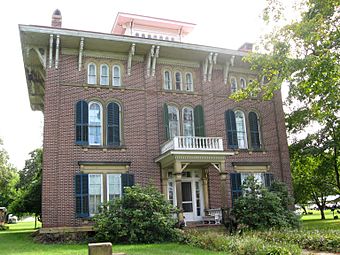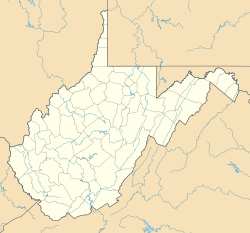Henderson Hall Historic District facts for kids
Quick facts for kids |
|
|
Henderson Hall Historic District
|
|
 |
|
| Location | CR 21/2 off WV 14, near Williamstown, West Virginia |
|---|---|
| Area | 65 acres (26 ha) |
| Built | earliest portions in 1836 |
| Architect | J. M. Slocomb |
| Architectural style | Italianate |
| NRHP reference No. | 86000811 |
| Added to NRHP | April 17, 1986 |
The Henderson Hall Historic District is a really cool historical spot in Boaz, West Virginia. It's listed on the National Register of Historic Places, which means it's super important for understanding history. The main building here is Henderson Hall, a beautiful old house built in the Italianate style.
But it's not just the main house! This historic district also includes other old buildings. There's a house where tenant farmers lived, and "Woodhaven," another home built in 1877. You can also find a smokehouse, two corn cribs (where corn was stored), a carriage barn that was also a school, and a scale house for farm equipment. Plus, there are two old barns. The district also has the Henderson family cemetery from the 1800s, a stone wall, a mounting block (to help get on horses), and even three ancient mounds built by the Adena culture long, long ago!
Henderson Hall was once a very large farm, or "plantation," before the American Civil War. It was important to the local area until about 1935. The Henderson family, who built and lived on the farm, stayed there until 1984. Then, a cousin named Michael Rolston took over. On April 17, 1986, Henderson Hall was officially added to the National Register of Historic Places. Today, it's a museum filled with amazing historical items. This farm was historically known as Pohick.
Contents
A Look Back in Time
The Henderson family owned a lot of land in the late 1700s and early 1800s. They were important farmers who helped create what is now Wood County, West Virginia, in 1798. By 1826, when George W. Henderson married Elizabeth Ann Tomlinson, the family owned about 2,000 acres in Wood County alone! They also had land in other parts of the region.
Before Henderson Hall was built in the late 1850s, the area was called Pohick. This name is thought to come from Native American languages. Before the American Civil War, George W. Henderson and three of his sons turned the land along the Ohio River into a large farm. They grew crops to sell, and raised cattle and horses. The farm used enslaved people to do much of the work. Besides being a historic farm, the site also has ancient mounds built by the Adena culture.
From Farm to Museum
In 1899, the site, still called Pohick, became a stop on the Ohio River Railroad. Even though the farm kept growing after the Civil War, and George W. Henderson's son, Jock B. Henderson, ran it until the 1930s, its importance started to fade after 1935.
In 1984, the last Henderson daughter, Lorna, passed away. Her cousin, Michael Rolston, moved into the home. He was a graphic designer from New York City. Rolston started giving tours of the house on weekends and at Christmas. He also worked hard to get the site listed on the National Register of Historic Places (NRHP). This happened on April 17, 1986. The listing included 10 buildings across 65 acres.
After Michael Rolston died in 2007, the Oil & Gas Museum in Parkersburg, West Virginia, took ownership. They decided to turn Henderson Hall into a museum for everyone to enjoy!
Exploring Henderson Hall
The most important building in the district is Henderson Hall itself. The oldest part of the house is a brick building from 1836. This part was made much bigger between 1856 and 1859 to create the Henderson Hall we see today.
The Main House
The 1850s part of the house was designed by J. M. Slocomb. It was built in the Italianate style, using brick, stone, and wood found right on the farm! This style has cool features like deep roof edges with fancy decorations called bracketwork. It also has decorative frames around the windows, railings and stone columns on the porch, and a small tower called a belvedere in the middle of the roof. The newer part of the house has sets of two windows. The house has a huge 8,000 square feet of space!
Inside, Henderson Hall is like a treasure chest. It holds many historic items. You can find things from the 1860 United States presidential election, a wedding dress from 1802, and a piano from 1873.
The 1836 part of the house has two stories and a pointed roof (a gabled roof). The newer, three-story addition has a special stone base. Both the main house and the belvedere tower have slanted roofs (called hipped roofs). When the house was nominated for the NRHP in 1986, people noted that the inside hadn't changed much. Only gas and electricity had been added. A newspaper in 2003 even said the house's parlor still had its original wallpaper!
Other Cool Spots on the Property
Many other buildings on the property are also considered important historical parts of the district.
- Smokehouse: There's a one-story log smokehouse with a gabled roof from about 1836.
- Old Schoolhouse: One of the oldest schools still standing in West Virginia is here! It was built around 1860 and was also used as a carriage barn. In 2019, it still had its original benches and school supplies.
- Farm Buildings: You can see two corn cribs, where corn was stored. One is from 1836, and the other from 1856. There's also a scale house from about 1856, which stored farm equipment. Two barns, from around 1850 and 1895, are also part of the property.
- Other Homes: Two other houses are included. One is a farmhouse from the late 1890s, where tenant farmers lived. It has a slate roof. The other is "Woodhaven" house, built by Henry Clay Henderson around 1877. It's a two-story house with an L-shaped design and gabled roofs.
- Family Cemetery: The Henderson Cemetery dates back to the early 1800s. Members of both the Henderson and Tomlinson families are buried there.
- Stone Wall: A stone wall from the mid-1800s, made from local stone, separates the buildings from the farmland along the Ohio River.
- Mounting Block: East of Henderson Hall, there's a sandstone block used to help people get onto horses more easily.
- Ancient Mounds: Three mounds built by the Adena culture are also part of the district. Mound A is the largest and is southwest of Henderson Hall. Mounds B and C are smaller and are located east of Mound A and north of Henderson Hall.
Images for kids




